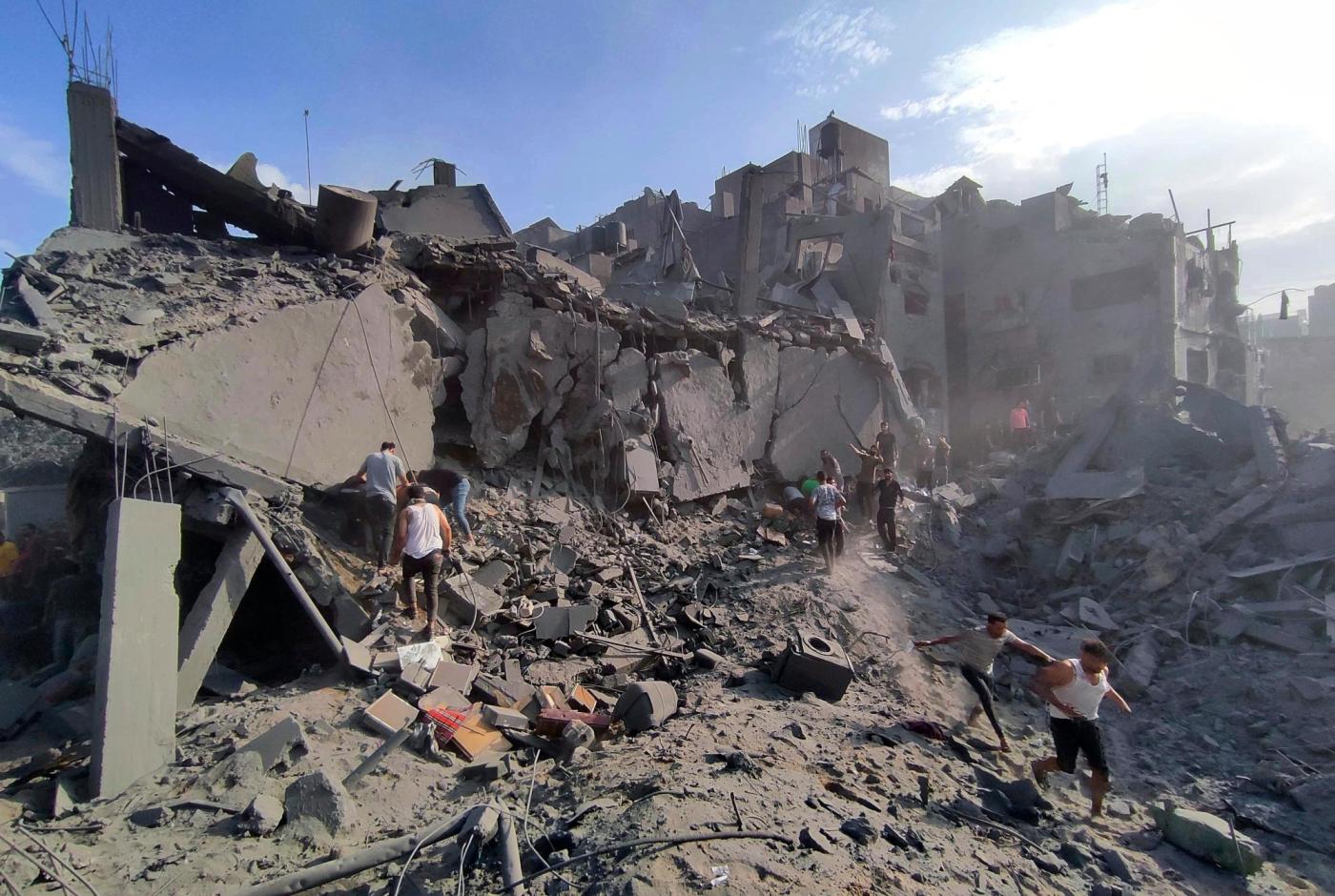
Zeynep Tufekci: Past lies about war in the Middle East are getting in the way of the truth today
Moshe Lavi, whose relatives have been taken hostage by Hamas, recently talked to a group of New York Times journalists about his family’s agony.
His pained voice turned to anger when he recounted encountering disbelief that Hamas committed terrible atrocities when it attacked Israel. Lavi seemed especially bewildered by people “arguing over the semantics” of whether people were beheaded or their heads fell off or even whether there were hostages in the Gaza Strip.
In one particularly gruesome twist, there’s been an uproar over whether Hamas had beheaded babies — an unverified claim that President Joe Biden repeated before the White House walked it back and has been subject to much discussion since.
Indeed, since Hamas did murder children and take others as hostages, should it get credit if it didn’t also behead them? It’s an appalling thought.
Some of this skepticism is surely the result of antisemitism. But that’s not all that’s going on.
One key reason for some of the incidents of doubt is the suspicion that horrendous but false or exaggerated claims are being used as a rationale for war — and there are many such historical examples, most notably the Iraq War.
Recently, a former permanent representative of Israel to the United Nations told Britain’s Sky News that he was “very puzzled by the constant concern which the world,” he said, “is showing for the Palestinian people.” He cited U.S. actions after Sept. 11 as a model for what Israel should do in response to Hamas’ shocking massacre of civilians on Oct. 7, which many have called Israel’s Sept. 11.
But if the U.S. response after Sept. 11 is a model, it is as a model of what not to do.
After the attacks, the United States received deep global sympathy. Many Muslims around the world were furious about this blemish upon Islam, even if they opposed U.S. policies: Citizens held vigils, politicians condemned the attacks and clerics repudiated them in mosque sermons. (The idea that Muslims widely celebrated the attacks has been repeatedly shown to be false or traces back to a few instances of dubious clarity.)
But, instead of mobilizing that widespread global sympathy to try to isolate the extremists, the United States chose to wage a reckless and destructive war in Iraq, driven by an impulsive desire for vengeance and justified by falsehoods about weapons of mass destruction.
The Bush administration’s lies in the lead-up to the war, the fiasco of its occupation and the chaos, violence and death that the invasion set off have deeply and indelibly damaged the standing and credibility of the United States and its allies.
People in the region were seared by images of Iraqi institutions — hospitals, ministries, museums — being looted while the U.S. military did little, of families shot as they returned home from a hospital or at checkpoints as they missed a hand signal or instructions shouted in English, of the torture and sadism at Abu Ghraib.
People also saw how occupation policies, such as the quick and thoughtless disbanding of the Iraqi army, contributed to the creation of the Islamic State group a decade later.
In the Middle East, the devastating aftermath of that war — justified by false claims — has never ended.
To make matters worse, the Israeli government has a long history of making false claims and denying responsibility for atrocities that later proved to be its doing.
In one example of many, in 2014, four boys younger than 13 were killed by Israeli airstrikes while playing by themselves at a beach — three of them hit by a second blast while desperately fleeing the initial blast.
There was first a concerted effort among some pro-Israel social media activists to claim the explosions were due to a Hamas rocket misfiring. The Israeli military initially claimed that “the target of this strike was Hamas terrorist operatives.” However, the beach was near a hotel housing journalists for Western outlets, including at least one from The New York Times, who witnessed the killings. The Guardian reported that journalists who visited the area in the aftermath saw no weapons or equipment and that kids regularly played there.
Israel then investigated and exonerated itself. Peter Lerner, then a spokesperson for the Israeli military, said that it had targeted a “compound belonging to Hamas’ Naval Police and Naval Force (including naval commandos) and which was utilized exclusively by militants.”
But The Telegraph, whose correspondent also witnessed the incident, reported that some of the journalists who had seen the bombing said there had been “no attempt to interview them.”
One can see how this history plays out in the global upheaval over the Hamas claim two weeks ago that an Israeli missile struck a hospital courtyard in Gaza. Israeli and American officials denied this and asserted that the missile came from within Gaza. There were also initial claims that 500 people were killed in the hospital blast, leading to headlines and global condemnations. Then the number was challenged, leading to another round of uproar and back-and-forth.
It is certainly possible that the hospital may have been accidentally hit by a missile fired in Gaza — such misfires have happened. But Israel’s bombardment has also caused large civilian casualties. The evidence isn’t conclusive either way, and the truth remains unknown.
Yet to a family that lost members in the hospital blast — which U.S. officials estimate killed hundreds — that squabble over exact numbers might seem as cruel as the skepticism about the atrocities committed by Hamas to an Israeli family that suffered during the Oct. 7 attack.
But there’s still the fact that fabricating or exaggerating atrocities is done to influence the calculus of what the public will accept — including what costs are justified to impose on civilians.
In 1990, after Saddam Hussein invaded Kuwait, there was widespread resistance in the United States to the idea of a new war — the country had not shaken “Vietnam syndrome,” that it was best for the United States to avoid large foreign military entanglements, both for practical and moral reasons.
It was in this context that a teenager testified before Congress in 1990 that she had seen Iraqi soldiers take premature babies out of incubators and leave them to die on the cold floor — a shocking assertion repeated by many high-level officials. The claim was widely repeated by officials and the media and even by Amnesty International.
Kept secret was the fact that the witness was the daughter of the Kuwaiti ambassador to the United States and her false testimony had likely been organized by a public relations firm working for the Kuwaiti government.
The shocking fabrication played a key role in the effort to sell the war to the reluctant American public. Needing to make sure oil fields stayed in the hands of the rulers of a tiny country created by colonial powers in the early 20th century went only so far. Opposing an army so savage that it commits the most unthinkable crimes is a more convincing appeal for war.
The terrible outcome of all this history is widespread distrust and dehumanization, as ordinary people’s loss and pain are viewed suspiciously as a potential cudgel that will cause further loss and pain for others.
Even people who I know have no sympathies toward Hamas or any kind of terrorism roll their eyes at some of the recent accounts of atrocities. “We always hear of something terrible when they want to go to war — how convenient,” one acquaintance told me recently.
There are plenty of echoes of this on social media. “Hamas beheaded babies, Saddam had WMD and I’m the last unicorn,” one person posted on X, formerly known as Twitter. Another one said, “The ‘40 babies beheaded by Hamas’ lie is equivalent to the WMD’s lie.”
Such sentiments are widespread.
All this highlights the importance of voices capable of retaining trust and consistent concern for all victims.
I was heartened to see that Human Rights Watch independently verified some of the videos of the horror on Oct. 7 and called the attacks deliberate killings. Similarly, Amnesty International’s independent investigation led the group to condemn the attacks as “cruel and brutal crimes including mass summary killings, hostage-taking.” Both organizations have called for the attacks to be investigated as war crimes.
Both organizations also have a history of documenting Israeli wrongdoings, including its treatment of civilians in Gaza and the West Bank, and both organizations have been vilified for doing so, especially by the government of Israel and some NGOs and lawmakers.
Yet these are the kinds of independent voices that need to be heard. In a context where many in the region and world already see the United States as reflexively supporting Israel, no matter its conduct, Biden might consider elevating such independent human rights voices rather than embracing Israeli Prime Minister Benjamin Netanyahu.
As Amnesty International states, kidnapping civilians is a war crime and the hostages should be released, unharmed. And their families shouldn’t have to endure this suspicion on top of their pain.
But to credibly demand that war crimes be stopped and lives respected requires equal concern extended to all victims, including the 2 million Palestinians in the Gaza Strip.
The victims are real — all of them — and that’s where all efforts to rebuild credibility or to seek a solution must begin.
Related Articles
Erwin Chemerinsky: Nothing has prepared me for the antisemitism I see on college campuses now
Margaret Tarkington: Crooked lawyers were crucial to Trump’s Jan. 6 plot. We clearly need to reform the profession.
Nicholas Kristof: The agonizing challenge of Gaza
Other voices: Schools should ban cellphones
Erwin Chemerinsky: How new House Speaker Mike Johnson tried again and again to overturn Biden’s election
Zeynep Tufekci writes a column for the New York Times.


